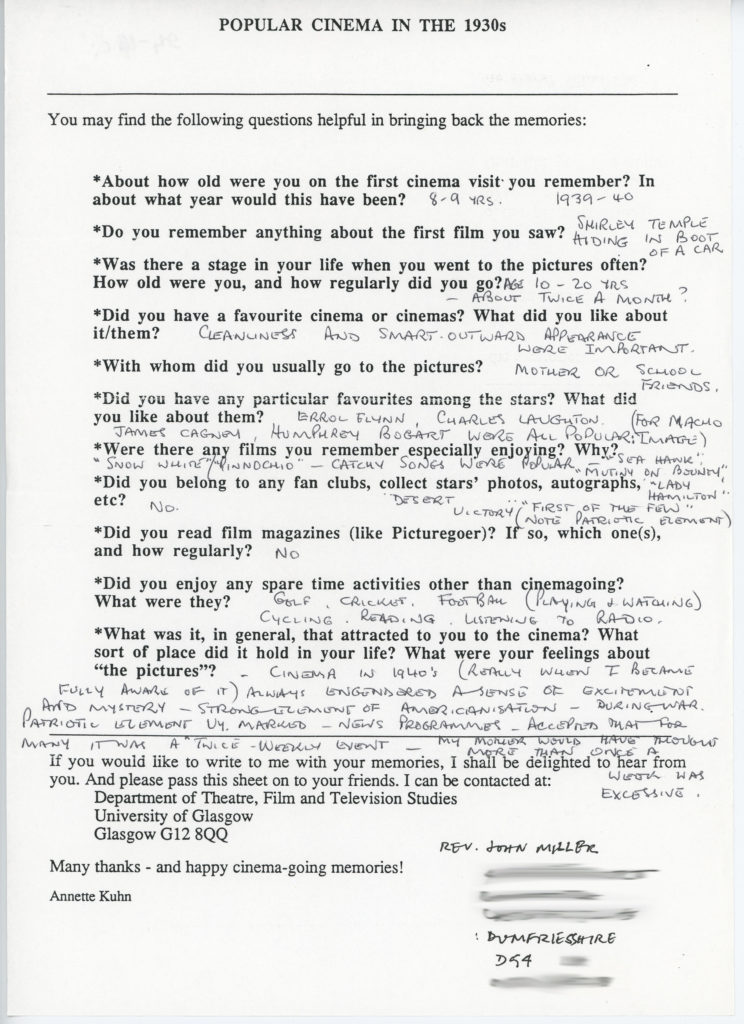A key feature of the Cinema Culture in 1930s Britain Collection is the interviews that were conducted during the mid-1990s in four UK locations, Glasgow, Greater Manchester, East Anglia, and the London suburb of Harrow: these places were carefully chosen to give a spread of settlement patterns and class and regional cultures. Interviews were piloted in the city of Glasgow in the southwest of Scotland, where the project was based at that time. A centre of shipbuilding and other heavy industry in the 1930s, this self-styled ‘movie-mad city’ was reputed at the time to have Europe’s highest number of cinema seats per head of population. Greater Manchester in the northwest of England was an important centre of the textile industry up till the 1970s, and during the 1930s was home to many cinemas, old and new. Fieldwork in the Greater Manchester conurbation incorporated the towns of Bolton (the site of Mass-Observation’s 1930s ‘Worktown’ studies) and Bury, as well as the city of Manchester itself. Situated to the north-west of London, Harrow underwent considerable growth during the 1930s, becoming transformed from a semi-rural area to a prosperous metropolitan suburb boasting several new supercinemas. In the 1930s as today, the predominantly rural counties of Suffolk and Norfolk in East Anglia featured a variety of settlement patterns, including small towns and seaside resorts, as well as villages of various sizes; while farming was the area’s main industry.
Interviewees were sought in several ways. Most of the Glasgow informants were selected from people who had been in contact with me before CCINTB was launched in 1994: attendees at a 1992 Glasgow Film Theatre screening and talk on popular cinema in the 1930s completed short question sheets and left their contact details if they wished to remain in touch (example pictured below); an appeal in a local newspaper, The Glaswegian, drew inquiries from further interested parties. Other Glasgow interviewees were previous contacts of the project’s Research Fellow. Pilot interviews with upwards of thirty individuals were conducted in Glasgow in late 1994 and early 1995. In the other locations, participants were sought through appeals in local media and national publications for the elderly; approaches were also made to, and came from, institutions and organisations of various kinds (local history societies, friendship groups, housebound library users’ services, residential homes for the elderly, and so on).

One-Page Question Sheet
From the pilot interviewees in Glasgow and the first contacts elsewhere a total of seventy-eight core informants were selected, with a view to balancing demographic factors such as location and social class in the 1930s, gender, and ethnicity. All but three of these participants were interviewed more than once, the majority twice, and a handful three times. Forty-five people were interviewed on their own, the rest in couples or groups. Interviews were conducted by Research Fellow Valentina Bold, an experienced oral history researcher. Most took place in participants’ homes, and a few in day centres, residential homes, or group meeting places. A total of 186 hours of tape-recorded interview material was gathered from core informants, mostly during 1995. In all but a handful of cases (where audio was of very poor quality, for example), these interviews were transcribed during the 1990s, and some of the Glasgow pilot interviews have been transcribed more recently.
All interview audio of acceptable quality has now been digitised in both WAV and MP3 format and we are in the process of indexing and time-stamping each interview. To enable visitors to perform keyword searching of the interview transcripts synced to the audio, we are using the Oral History Metadata Synchronizer application, developed by the University of Kentucky Libraries. See the Participant Interviews area for details of how to access the interviews.
For further information on interviews, interviewees, and other aspects of CCINTB’s research design, see Kuhn, A. (2002) An Everyday Magic (London: I.B.Tauris), pp.240-254.
Annette Kuhn
49 thoughts on “Annette Kuhn talks about a key aspect of CCINTB’s research design”
Comments are closed.